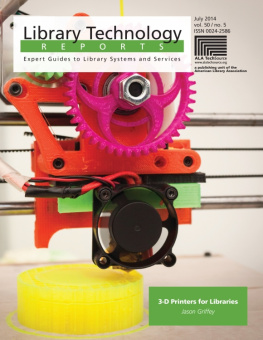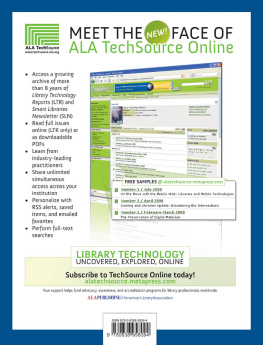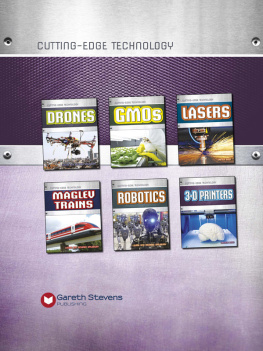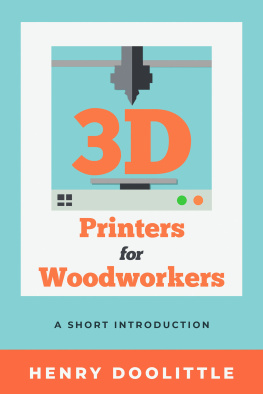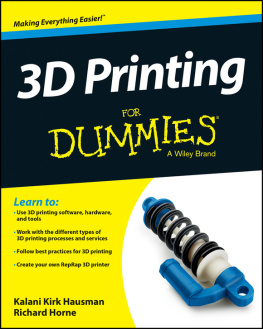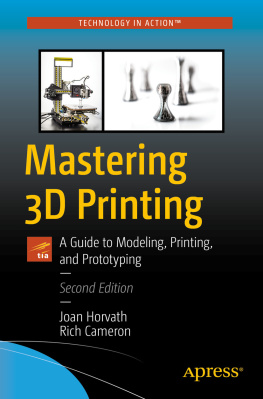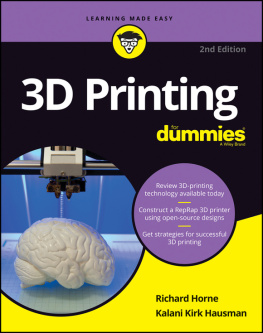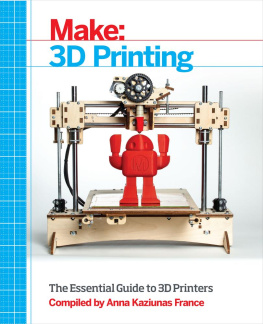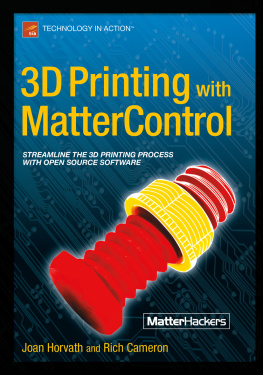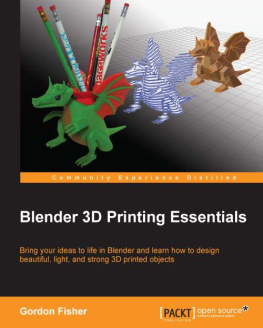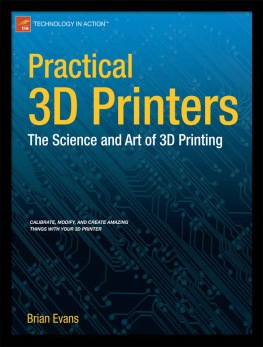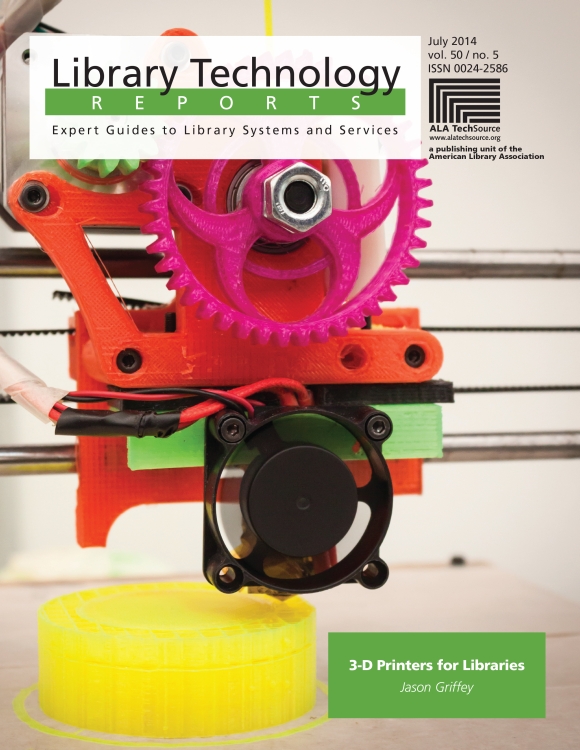
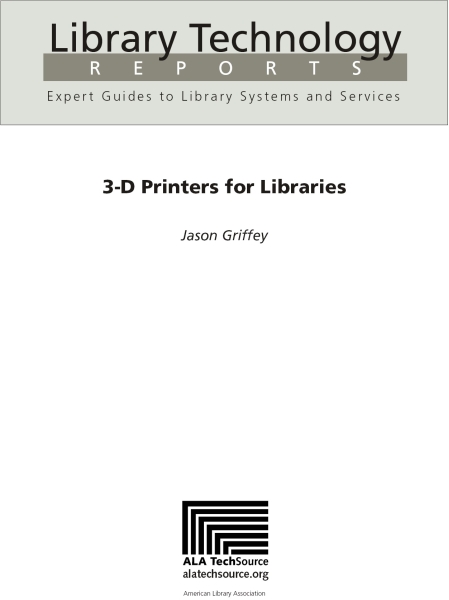
Library Technology Reports
ALA TechSource purchases fund advocacy, awareness, and accreditation programs for library professionals worldwide.
Volume 50, Number 5
3-D Printers for Libraries
ISBNs: (print) 978-0-8389-5930-5; (PDF) 978-0-8389-5931-2; (ePub) 978-0-8389-5932-9; (Kindle) 978-0-8389-5933-6.
American Library Association
50 East Huron St.
Chicago, IL 60611-2795 USA
alatechsource.org
800-545-2433, ext. 4299
312-944-6780
312-280-5275 (fax)
Advertising Representative
Patrick Hogan
312-280-3240
Editor
Patrick Hogan
312-280-3240
Copy Editor
Judith Lauber
Production and Design
Tim Clifford, Production Editor
Karen Sheets de Gracia, Manager of Design and Composition
Library Technology Reports (ISSN 0024-2586) is published eight times a year (January, March, April, June, July, September, October, and December) by American Library Association, 50 E. Huron St., Chicago, IL 60611. It is managed by ALA TechSource, a unit of the publishing department of ALA. Periodical postage paid at Chicago, Illinois, and at additional mailing offices. POSTMASTER: Send address changes to Library Technology Reports, 50 E. Huron St., Chicago, IL 60611.
Trademarked names appear in the text of this journal. Rather than identify or insert a trademark symbol at the appearance of each name, the authors and the American Library Association state that the names are used for editorial purposes exclusively, to the ultimate benefit of the owners of the trademarks. There is absolutely no intention of infringement on the rights of the trademark owners.

alatechsource.org
Copyright 2014 Jason Griffey
Licensed under Creative Commons Attribution-NonCommercial 4.0 International (CC BY-NC 4.0).
http://creativecommons.org/licenses/by-nc/4.0/
About the Author
Jason Griffey is the founder and principal consultant at Evenly Distributed (http://evenlydistributed.net), a technology consulting firm for libraries and education. He has written extensively on libraries and technology, most recently a chapter in The Top Technologies Every Librarian Needs to Know: A LITA Guide. His previous book, Mobile Technology and Libraries, is a part of the award-winning Tech Set series. Named a Library Journal Mover & Shaker in 2009, Griffey has written and spoken internationally on topics such as the future of technology and libraries, personal electronics in the library, privacy, copyright, and intellectual property. Griffey is the designer and director of The LibraryBox Project (http://librarybox.us), an open-source portable digital file distribution system.
Abstract
Library Technology Reports (vol. 50, no. 5) 3-D Printers for Libraries offers an explanation of the various types of 3-D printers, how they work, and the materials used. The Report describes a range of specific 3-D printing products appropriate for library use.
Get Your Library Technology Reports Online!
Subscribers to ALA TechSources Library Technology Reports can read digital versions, in PDF and HTML formats, through the scholarly content host MetaPress. Subscribers also have access to an archive of past issues. Visit , if you have any questions about or problems with access.
Subscriptions
alatechsource.org/subscribe
Contents
Chapter 1
Abstract
Chapter 1 of Library Technology Reports (vol. 50, no. 5) 3-D Printers for Libraries explains the mechanical process of a 3-D printer. Author Jason Griffey raises a few library-specific issues and makes an argument for libraries to implement 3-D printing.
O ver the last two to three years, there has been an explosion of interest in 3-D printing in libraries. This has been driven by the falling cost of the technology and the rise in interest in interactive, creative spaces inside libraries (makerspaces or tinkerlabs). 3-D printing as a technology isnt new; its been available commercially for decades. But only in the last five years or so has the price for deposition printers, driven by dedicated hobbyists and the company MakerBot Industries, dropped to the point where they are within the reach of the average individual.
There are a number of reasons that libraries should be looking at 3-D printing as an addition to their technology services. The first is that libraries, especially public libraries, have often been a technological leveler for their communities. Libraries were the first place where many people came to print their rsums on a laser printer. (Its easy to forget how transformative high-quality printing was in the late 1980s.) They were also the first place where many people had an experience with the Internet, especially with the World Wide Web, in the mid-1990s. Going back to pre-computer technologies, the local public library was the place where someone could go and use a typewriter that was freely available. So libraries have a well-worn history of being places where new technologies can be seen and interacted with for the first time. 3-D printers are at the point now where the personal computer was in 1984; they are mostly a hobbyist pursuit, but they have a clear future.
That future is as varied as the objects these printers can create. There are a number of traditional mechanisms for creating things in plastic, ranging from machining and milling (subtractive manufacturing) to molding and vacuum forming. In most cases, these are optimized for creating a high volume of identical plastic parts, such as tens of thousands of action figures or hundreds of thousands of appliance parts. They are almost impossible to use cost-effectively if you want just one of something, and thats where 3-D printing shines. With a 3-D printer, you can create unlimited numbers of unique objects for the same price. Need a replacement part for a toy? No problem. And then when you need a doorstop or a speaker frame or something totally other, thats not a problem either. If youre making ten thousand copies of a thing, there are more cost-effective options. But if you need just one, there is no better option than printing it.
This flexibility is key to the uptake of the technology, especially in libraries. Each patron can design and create his or her own particular object. Kids can print new additions to the toys that they love and can create just about anything that they can imagine.
The simplest way to imagine a 3-D printer is that its a machine that makes bigger things out of smaller blocks. In some cases, the blocks are a powder; in others, they are melted plastic; and in yet others, they are an ultraviolet light-sensitive resin, but in every case its just a matter of large things being made from smaller substrates. A 3-D printer is a simple sort of robot that understands how to manipulate the raw material its working with in three dimensions rather than just two, as an ink-jet or laser printer does. This type of manufacturing is also called additive manufacturing, as opposed to more traditional subtractive manufacturing where material is removed from a larger sample to create custom shapes in a process like milling, lathing, or CNC (computing numerical control) machines.
Imagine that you take an ink-jet printer, and instead of printing ink, it extrudes hot plastic that cools quickly. Think of it like a hot glue gun, where the plastic is solid, then gets heated to a liquid state, and then cools again into a solid. If it printed this plastic onto a piece of paper, youd end up with a slightly raised design being drawn on the paper by the printhead moving back and forth across the paper (the X dimension) and the paper being moved through the print area (the Y dimension). Those of us old enough to remember the days when color printing was very expensive might have memories of hot-wax printers that did basically this.
Next page
